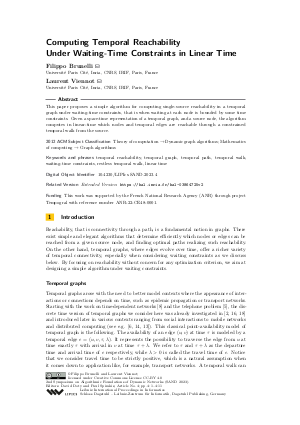Computing Temporal Reachability Under Waiting-Time Constraints in Linear Time
Authors Filippo Brunelli, Laurent Viennot
-
Part of:
Volume:
2nd Symposium on Algorithmic Foundations of Dynamic Networks (SAND 2023)
Part of: Series: Leibniz International Proceedings in Informatics (LIPIcs)
Part of: Conference: Symposium on Algorithmic Foundations of Dynamic Networks (SAND) - License:
 Creative Commons Attribution 4.0 International license
Creative Commons Attribution 4.0 International license
- Publication Date: 2023-06-12
File

PDF
LIPIcs.SAND.2023.4.pdf
- Filesize: 0.67 MB
- 11 pages
Document Identifiers
Related Versions
- Extended Version https://hal.inria.fr/hal-03864725v2
Subject Classification
ACM Subject Classification
- Theory of computation → Dynamic graph algorithms
- Mathematics of computing → Graph algorithms
Keywords
- temporal reachability
- temporal graph
- temporal path
- temporal walk
- waiting-time constraints
- restless temporal walk
- linear time
Metrics
- Access Statistics
-
Total Accesses (updated on a weekly basis)
0Document
0Metadata
Abstract
This paper proposes a simple algorithm for computing single-source reachability in a temporal graph under waiting-time constraints, that is when waiting at each node is bounded by some time constraints. Given a space-time representation of a temporal graph, and a source node, the algorithm computes in linear-time which nodes and temporal edges are reachable through a constrained temporal walk from the source.
Cite As Get BibTex
Filippo Brunelli and Laurent Viennot. Computing Temporal Reachability Under Waiting-Time Constraints in Linear Time. In 2nd Symposium on Algorithmic Foundations of Dynamic Networks (SAND 2023). Leibniz International Proceedings in Informatics (LIPIcs), Volume 257, pp. 4:1-4:11, Schloss Dagstuhl – Leibniz-Zentrum für Informatik (2023)
https://doi.org/10.4230/LIPIcs.SAND.2023.4
BibTex
@InProceedings{brunelli_et_al:LIPIcs.SAND.2023.4,
author = {Brunelli, Filippo and Viennot, Laurent},
title = {{Computing Temporal Reachability Under Waiting-Time Constraints in Linear Time}},
booktitle = {2nd Symposium on Algorithmic Foundations of Dynamic Networks (SAND 2023)},
pages = {4:1--4:11},
series = {Leibniz International Proceedings in Informatics (LIPIcs)},
ISBN = {978-3-95977-275-4},
ISSN = {1868-8969},
year = {2023},
volume = {257},
editor = {Doty, David and Spirakis, Paul},
publisher = {Schloss Dagstuhl -- Leibniz-Zentrum f{\"u}r Informatik},
address = {Dagstuhl, Germany},
URL = {https://drops.dagstuhl.de/entities/document/10.4230/LIPIcs.SAND.2023.4},
URN = {urn:nbn:de:0030-drops-179402},
doi = {10.4230/LIPIcs.SAND.2023.4},
annote = {Keywords: temporal reachability, temporal graph, temporal path, temporal walk, waiting-time constraints, restless temporal walk, linear time}
}
Author Details
Funding
This work was supported by the French National Research Agency (ANR) through project Tempogral with reference number ANR-22-CE48-0001.
References
-
Matthias Bentert, Anne-Sophie Himmel, André Nichterlein, and Rolf Niedermeier. Efficient computation of optimal temporal walks under waiting-time constraints. Appl. Netw. Sci., 5(1):73, 2020.

-
Kenneth A. Berman. Vulnerability of scheduled networks and a generalization of menger’s theorem. Networks, 28(3):125-134, 1996.

-
Gerth Stølting Brodal and Riko Jacob. Time-dependent networks as models to achieve fast exact time-table queries. Electron. Notes Theor. Comput. Sci., 92:3-15, 2004.

- Filippo Brunelli and Laurent Viennot. Minimum-cost temporal walks under waiting-time constraints in linear time. CoRR, abs/2211.12136, 2022. URL: https://doi.org/10.48550/arXiv.2211.12136.
-
Richard T. Bumby. A problem with telephones. SIAM. J. on Algebraic and Discrete Methods, 2(1):13-18, 1981.

-
Arnaud Casteigts, Paola Flocchini, Walter Quattrociocchi, and Nicola Santoro. Time-varying graphs and dynamic networks. IJPEDS, 27(5):387-408, 2012.

-
Arnaud Casteigts, Anne-Sophie Himmel, Hendrik Molter, and Philipp Zschoche. Finding temporal paths under waiting time constraints. Algorithmica, 83(9):2754-2802, 2021.

-
Kenneth L. Cooke and Eric Halsey. The shortest route through a network with time-dependent internodal transit times. Journal of Mathematical Analysis and Applications, 14(3):493-498, 1966.

-
Pierluigi Crescenzi, Clémence Magnien, and Andrea Marino. Approximating the temporal neighbourhood function of large temporal graphs. Algorithms, 12(10):211, 2019.

-
Julian Dibbelt, Thomas Pajor, Ben Strasser, and Dorothea Wagner. Intriguingly Simple and Fast Transit Routing. In Experimental Algorithms, Lecture Notes in Computer Science, pages 43-54. Springer, 2013.

-
Julian Dibbelt, Thomas Pajor, Ben Strasser, and Dorothea Wagner. Connection scan algorithm. ACM Journal of Experimental Algorithmics, 23:1.7:1-1.7:56, 2018.

-
Arthur B. Kahn. Topological sorting of large networks. Commun. ACM, 5(11):558-562, 1962.

-
Matthieu Latapy, Tiphaine Viard, and Clémence Magnien. Stream graphs and link streams for the modeling of interactions over time. Social Netw. Analys. Mining, 8(1):61:1-61:29, 2018.

-
Othon Michail. An introduction to temporal graphs: An algorithmic perspective. Internet Mathematics, 12(4):239-280, 2016.

-
Matthias Müller-Hannemann, Frank Schulz, Dorothea Wagner, and Christos D. Zaroliagis. Timetable information: Models and algorithms. In ATMOS, volume 4359 of Lecture Notes in Computer Science, pages 67-90. Springer, 2004.

-
Karl Nachtigall. Time depending shortest-path problems with applications to railway networks. European Journal of Operational Research, 83(1):154-166, 1995.

-
Stefano Pallottino and Maria Grazia Scutellà. Shortest path algorithms in transportation models: classical and innovative aspects. Technical Report TR-97-06, University of Pisa, 1997.

-
Stefano Pallottino and Maria Grazia Scutellà. Equilibrium and Advanced Transportation Modelling, chapter Shortest path algorithms in transportation models: classical and innovative aspects, pages 245-281. Kluwer Academic Publishers, 1998.

-
Frank Schulz, Dorothea Wagner, and Karsten Weihe. Dijkstra’s algorithm on-line: An empirical case study from public railroad transport. ACM J. Exp. Algorithmics, 5:12, 2000.

-
Huanhuan Wu, James Cheng, Silu Huang, Yiping Ke, Yi Lu, and Yanyan Xu. Path Problems in Temporal Graphs. VLDB Endowment, 7(9):721-732, 2014.

